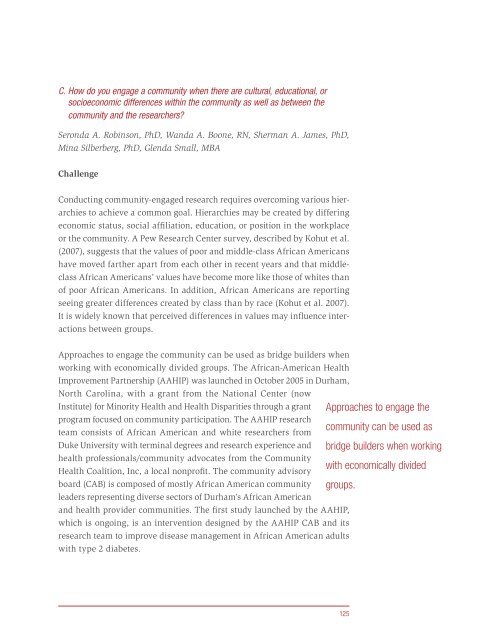Principles of Community Engagement (Second Edition)
Principles of Community Engagement (Second Edition)
Principles of Community Engagement (Second Edition)
Create successful ePaper yourself
Turn your PDF publications into a flip-book with our unique Google optimized e-Paper software.
C. How do you engage a community when there are cultural, educational, or<br />
socioeconomic differences within the community as well as between the<br />
community and the researchers?<br />
Seronda A. Robinson, PhD, Wanda A. Boone, RN, Sherman A. James, PhD,<br />
Mina Silberberg, PhD, Glenda Small, MBA<br />
Challenge<br />
Conducting community-engaged research requires overcoming various hierarchies<br />
to achieve a common goal Hierarchies may be created by differing<br />
economic status, social affiliation, education, or position in the workplace<br />
or the community A Pew Research Center survey, described by Kohut et al<br />
(2007), suggests that the values <strong>of</strong> poor and middle-class African Americans<br />
have moved farther apart from each other in recent years and that middleclass<br />
African Americans’ values have become more like those <strong>of</strong> whites than<br />
<strong>of</strong> poor African Americans In addition, African Americans are reporting<br />
seeing greater differences created by class than by race (Kohut et al 2007)<br />
It is widely known that perceived differences in values may influence interactions<br />
between groups<br />
Approaches to engage the community can be used as bridge builders when<br />
working with economically divided groups The African-American Health<br />
Improvement Partnership (AAHIP) was launched in October 2005 in Durham,<br />
North Carolina, with a grant from the National Center (now<br />
Institute) for Minority Health and Health Disparities through a grant<br />
program focused on community participation The AAHIP research<br />
team consists <strong>of</strong> African American and white researchers from<br />
Duke University with terminal degrees and research experience and<br />
health pr<strong>of</strong>essionals/community advocates from the <strong>Community</strong><br />
Health Coalition, Inc, a local nonpr<strong>of</strong>it The community advisory<br />
board (CAB) is composed <strong>of</strong> mostly African American community<br />
leaders representing diverse sectors <strong>of</strong> Durham’s African American<br />
and health provider communities The first study launched by the AAHIP,<br />
which is ongoing, is an intervention designed by the AAHIP CAB and its<br />
research team to improve disease management in African American adults<br />
with type 2 diabetes<br />
Approaches to engage the<br />
community can be used as<br />
bridge builders when working<br />
with economically divided<br />
groups.<br />
125

















